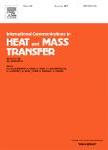版权所有:内蒙古大学图书馆 技术提供:维普资讯• 智图
内蒙古自治区呼和浩特市赛罕区大学西街235号 邮编: 010021

作者机构:Univ Fed Rio Grande FURL Grad Program Computat Modeling Italia AveKm 8 BR-96201900 Rio Grande RS Brazil
出 版 物:《INTERNATIONAL COMMUNICATIONS IN HEAT AND MASS TRANSFER》 (国际传热与传质通讯)
年 卷 期:2020年第111卷
页 面:104458-104458页
核心收录:
学科分类:080702[工学-热能工程] 08[工学] 0807[工学-动力工程及工程热物理] 0801[工学-力学(可授工学、理学学位)]
基 金:Coordenacao de Aperfeicoamento de Pessoal de Nivel Superior - CAPES Conselho Nacional de Desenvolvimento Clentifico e Tecnologic - CNPq [306024/2017-9, 306734/2016-8]
主 题:Deterministic algorithm Tube heat exchanger Numerical Modeling Constructal Theory
摘 要:Present work performs a numerical study about the energy removal in a heated tubular array submitted to an external flow. Taking into account that a large variety of tubular arrangements can exists, in this work it is developed a tubular array that does not use any kind of initial predefined arrangement. Using the principles of Constructal Theory (or Law) and a positioning function dependent on the velocity and temperature fields, it is calculated, in a deterministic way, the location where each tube should be positioned. Pressure drop is not taken in to account in this first algorithm implementation as a performance indicator. In order to validate the proposed methodology, the Constructal Array is compared with standard aligned and staggered arrangements suggested in literature. The minimum distance between tubes (p) is considered as a degree of freedom. Four variations are studied: p = 1D, p = 1.25D, p = 1.5D and p = 2D, where D is the tube diameter. It is considered here the simulation of a transient, incompressible and laminar flow of a Newtonian fluid in a two-dimensional domain with forced convection and Prandtl number equal to 0.71. Results are computed when the flow reaches to the steady state condition. It is evaluated three values for Reynolds number: Re-D = 10, 50 and 100. Thermal analysis of the formed patterns has shown that best thermal performance was not obtained with p = 1D, neither with p = 2D, i.e., tube distance has an influence on its formation and, consequently, on the heat transfer exchange. In all performed analyzes, Constructal arrays configuration showed higher energy removal (up to 71%) than the aligned and staggered arrangements, which highlights the capacity of proposed method. Constructal Array for p = 1.5D showed the most homogeneous distribution and proved to be the most effective in 4 of the six studied cases.